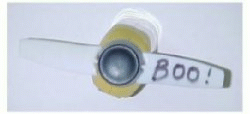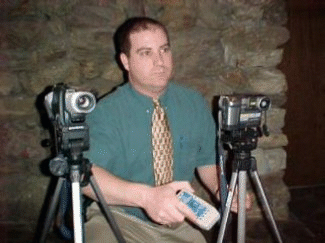
a 3-D camera
A ghost hunter's greatest trophy is usually a good photograph. By assimilating as much visual knowledge as possible, researchers are trying to better understand the physical makeup of ghosts.
Ghosts cannot always be seen with the naked eye. It seems for them to materialize, or become visible to humans, the atmospheric conditions might have to be just right. However, both still and video cameras can capture things our eyes cannot see.

For example, our eyes can't see a fan blade on high speed.

However, if we photograph it with a film or digital camera, at the right shutter speed or exposure setting, the blade becomes visible. Perhaps ghosts normally oscillate at a higher rate than the human eye can perceive and the human brain can piece together. Cameras can capture images too fleeting for our eyes to see.
Photos taken in haunted areas can yield mists, orbs (balls of light), vortexes, cloudy forms of all kinds, and full-bodied apparitions. Critics claim that some of these forms may be developing flaws, reflections, or flash glares. However, L.E.M.U.R. incorporates 3-D stereoscopic photography in our research. If a ghostly form or image occupies 3-dimensional space, then it cannot be a simple reflection or glare.

We use infrared and ultraviolet photography, as well as digital imaging, to capture the visual environment. By employing all means of photography, 2-D and 3-D, film and digital, IR, UV, night vision, still and video, we record all available visual information. In haunted locations, the results are often startling.
 You may want to VISIT our online gallery of ghostly photographs. You may want to VISIT our online gallery of ghostly photographs.
|



